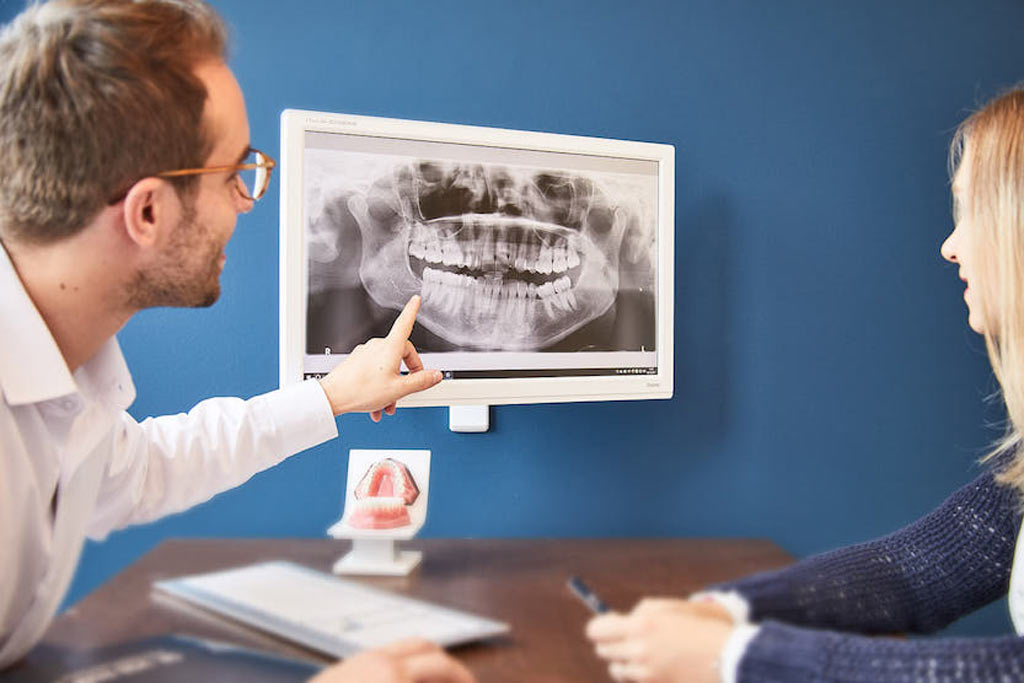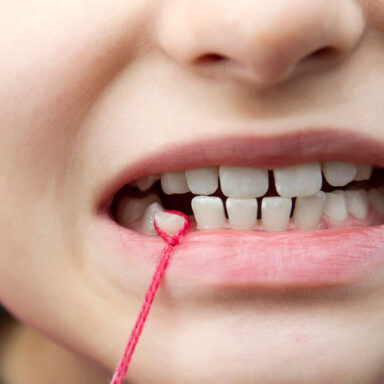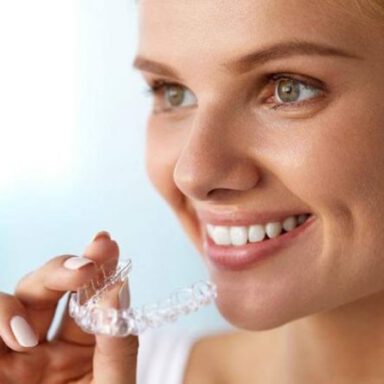Guidebook
Orthodontics as an alternative to dental implants

Orthodontic gap closure – an alternative to implants (dental implants)
If a tooth is missing, dental implants are often suggested to fill the gap. A good alternative to dental implants can be orthodontic gap closure. With the help of braces, the teeth are moved so that the gap is closed with the patient’s own teeth and an artificial tooth in the form of an implant becomes superfluous. Such orthodontic treatments are also possible for adults. Thanks to the so-called lingual technique, they are even invisible. In this article, we would like to show you the advantages of orthodontics as an alternative to dental implants.

Author
Dr. Fabian von Rom
Date
Estimated reading time
approx. 7 min
Alternative to dental implants
Contents
What is a dental implant?
A dental implant is an artificial tooth that is used to replace a lost tooth or a tooth that has not been attached from the start (non-attachment). The dentist anchors a screw (implant) as an artificial tooth root in the jawbone. An artificial dental crown is then attached to the implant. As the jawbone and gums usually recede somewhat in the course of life, implants can become unaesthetic in the long term, especially in the front tooth area.
Are there alternatives to dental implants?
There are basically two alternatives to dental implants: bridges and orthodontic gap closure.
- Just like a dental implant, a bridge is an artificial tooth replacement. The dental crown to be replaced is not attached to a screw in the jaw as with an implant, but to the neighboring teeth. This requires extensive grinding. This is particularly undesirable in the case of healthy neighboring teeth. As the replaced tooth is not positioned in the jawbone like a real tooth, the long-term results with bridges are often aesthetically unsatisfactory, similar to implants in the anterior region.
- Orthodontics offers a good alternative to dental implants, as the missing tooth does not have to be replaced by artificial teeth or tooth roots. With the help of braces, the teeth are moved during orthodontic gap closure so that a natural tooth closes the gap at the end. Orthodontics is also still possible for adults. With internal braces(lingual technique), it can even be completely invisible.
When permanent teeth are not attached (non-attachment) – orthodontics as an alternative to implants
In children, the lower molars and lateral upper incisors are most frequently missing. If it is determined that a permanent tooth has not formed, the primary tooth is often still present. Unfortunately, experience shows that milk teeth usually fall out at some point, even if the permanent tooth is not present. It therefore makes sense to think about how the missing tooth should be replaced at an early stage: With a dental implant or alternatively by orthodontic gap closure? When closing the gap, the teeth behind the gap are moved forward by one tooth width using braces. This results in a closed row of teeth again, completely without an artificial tooth (implant).
Dental implants are not subsidized by statutory health insurance companies, even if permanent teeth are not present. The situation is different for orthodontic gap closure. Up to the age of 18, the statutory health insurance funds contribute to the costs of orthodontic treatment if the teeth are not fitted. Overall, closing the gap in adolescence is therefore usually the cheaper alternative to a dental implant.
If a baby tooth is lost during childhood or teenage years without a permanent tooth coming in, orthodontics is a particularly sensible alternative to an implant. A dental implant can usually only be placed after the age of 18. This means that patients have to live with a gap between their teeth or temporary dentures for years. The unloaded jawbone in this area often recedes over time. This makes subsequent implant placement more difficult and can lead to compromises in aesthetics. With orthodontics as an alternative to implants, the final result is usually achieved well before the age of 18.
Tooth loss – avoid dental implants through orthodontic gap closure
There are many reasons why a tooth may be lost. Regardless of whether a sports accident or deep caries is to blame, nobody wants to live with a gap between their teeth. Even in adults, orthodontic gap closure is often possible as an alternative to dental implants.
As the teeth, including the root, have to be moved, there is usually no way around fixed braces. But don’t worry! There are also invisible braces. At our practice in Munich-Unterföhring, we specialize in the so-called lingual technique. This involves invisibly attaching the braces to the inside of the teeth. Thanks to our large number of cases and experience in this field, we are also able to carry out complex orthodontic treatments invisibly.

What needs to be taken into account when closing orthodontic gaps? When is orthodontic gap closure not an alternative to a dental implant?
- Tooth shape and anterior aesthetics: If an incisor is missing in the upper jaw and all teeth are moved forward by one tooth width to close the gap, a canine tooth ends up in place of an incisor and a small molar tooth in place of the canine tooth and so on. Apart from the shape of the tooth, canines are usually also slightly different in color from the incisors. They are usually slightly darker. It is therefore very important to assess whether the shape and color of the affected teeth are generally suitable for gap closure. If this is the case, the layperson will often not even notice that a canine tooth is in the place of an incisor. The experienced dentist can often improve the result even further by making small aesthetic adjustments.
When bone and gums recede over the course of a lifetime, an implant tooth behaves differently to its neighboring natural teeth. In the visible area (front tooth implant), this can have a negative effect on the aesthetics of the smile. If the basic requirements in terms of tooth shape and shade are met, we therefore often advise our patients in the anterior region to close the gap orthodontically as an alternative to a dental implant. - Support of all teeth: It is important that all teeth have an opposing tooth at the end of the treatment and that good interlocking between the upper and lower jaw is ensured. If, for example, one tooth in the lower jaw is not attached and there is no wisdom tooth on this side, closing the gap in the lower jaw would mean that the last tooth in the upper jaw would no longer have an opposing tooth. In this case, orthodontics would not be a good alternative to implants.
How long does a gap closure treatment at the orthodontist take?
How long it takes to close a gap with braces depends on many factors. Among other things, the size of the gap between the teeth plays a role. The smaller the gap, the faster the gap closure. As a rule of thumb, it can be said that 0.5 mm to 1.0 mm gap closure per month is realistic.
Your expert for orthodontics
Dr. Fabian von Rom
In the specialist practice for orthodontics, Dr. med, dent. Fabian von Rom uses his extensive expertise and many years of experience to offer patients the best possible care. The practice offers the entire spectrum of modern orthodontics and specializes in innovative and advanced treatment methods. In addition to traditional procedures, the focus is on treatment with invisible braces for teenagers and adults – one of the most modern and discreet solutions in orthodontics. Dr. med. dent. Fabian von Rom attaches great importance to ensuring that medical precision goes hand in hand with a high level of patient satisfaction. By equipping the practice exclusively with individual treatment rooms, individual and professional care at the highest level is guaranteed.

Further topics
In our guide you will find lots more information on current, relevant and interesting topics relating to orthodontics. We hope you enjoy reading it!



